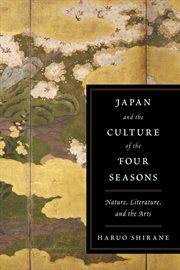Nonfiction
eBook
Details
PUBLISHED
DESCRIPTION
1 online resource
ISBN/ISSN
LANGUAGE
NOTES
Elegant representations of nature, explicitly the four seasons, fill a wide range of Japanese genres and media-from poetry and screen painting to tea ceremony, flower arrangement, and annual observances. Haruo Shirane shows, for the first time, how, when, and why this occurred and explicates the richly encoded social, religious, and political meanings these representations embodied. Refuting the long held belief that this phenomenon reflects agrarian origins, this book demonstrates how elegant representations of the four seasons first emerged in an urban environment among nobility in the eight century. They became highly codified and then spread to different social classes, eventually settling in popular culture and the pleasure quarters. Shirane accounts for all types of manifestations: textual (poetry, chronicles, tales), cultivated (gardens, flower arrangement), material (kimonos, screens), performative (noh drama, festivals), and gastronomic (tea ceremony, food rituals). He reveals how this kind of "secondary nature," which flourished in Japan's urban architecture and gardens, frequently fostered a sense of harmony with the natural world-just at the point at which it was receding. Eventually, alternative representations of nature derived from farm villages and elsewhere began to intersect with these elegant representations in the capital, creating a complex web of competing associations. Anyone with an interest in Japanese visual arts, literature, cultural history, and social customs will relish this book, which illuminates the deeper meaning behind Japanese aesthetics and artifacts. Shirane explicates nature's complex codification, especially the use of images, the seasons to which they were attached, and the changes in cultural associations across history, genre, and community. His fascinating research shows these seasons to be as much a cultural construction as a reflection of the physical world
Mode of access: World Wide Web







